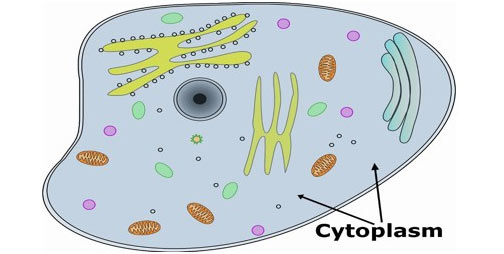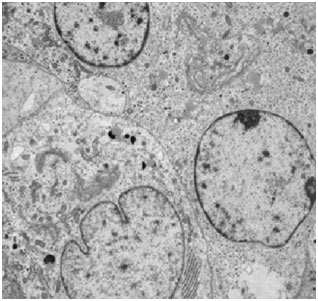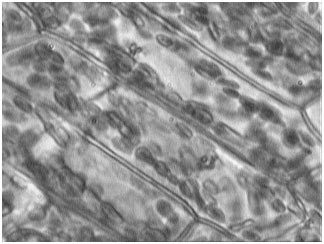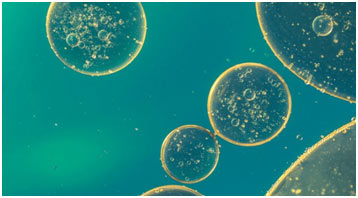Cytoplasm
The cytoplasm was discovered in the year 1835 by Robert Brown and other researchers.
The cytoplasm is the semi-viscous ground substance of the cell. All the volume of such substances outside the nucleus and inside the plasma membrane is cytoplasm.
It is often described as the non-nuclear content of the protoplasm. All the cellular contents in prokaryotes are consisted of within the cell’s cytoplasm.
In eukaryote organisms, the nucleus of the cell is separated from the cytoplasm.
The cytoplasm is the compound of life, it works as a molecular soup and it is in the cytoplasm where all the cellular organelles are suspended and bound together by a lipid bilayer membrane.

- 1) Structure of the Cytoplasm
- 2) The Cytosol
- 3) Organelles
- 4) Cytoplasmic Inclusions
- 5) Properties of Cytoplasm
- 6) Functions of Cytoplasm
- 7) Cytoplasmic Streaming
- 8) Cytoplasmic Inheritance
- 9) Multiple-Choice Questions (MCQs) on Cytoplasm:
- 10) Frequently Asked Questions (FAQs) about Cytoplasm:
- 11) Wrap Up
Structure of the Cytoplasm
The primary elements of the cytoplasm are:
- Cytosol– a gel-like substance
- Organelles– the cell’s internal sub-structures, and
- Numerous cytoplasmic inclusions.
The Cytosol
The cytosol is the part of the cytoplasm that is not inhabited by any organelle. It is a gelatinous fluid, where other elements of the cytoplasm remain suspended. It primarily includes cytoskeleton filaments, organic particles, salt, and water.
Organelles
Organelles imply “little organs”, that are membrane-bound. They are present inside the cell and carry out specific functions that are essential for the survival of the cell. Some of the constituents of the cell that are suspended in the cytosol are cellular organelles like mitochondria, endoplasmic reticulum, Golgi complex, vacuoles, lysosomes, and chloroplasts in plant cells.
Cytoplasmic Inclusions
The cytoplasmic inclusions include different kinds of insoluble particles or particles that remain suspended in the cytosol. Cytoplasmic inclusions are not surrounded by any membrane. They are basically granules of starch and glycogen, and they can store energy.
A large series of inclusions exist in various cell types. The inclusions vary from calcium oxalate crystals or silicon dioxide crystals in plants to storage granules of materials like starch, glycogen, etc. Lipid droplets are a widespread example of inclusions, these are round beads, they are made from lipids and proteins and are present in both prokaryotes and eukaryotes as a medium to store lipids like fatty acids and sterols.
Properties of Cytoplasm
- The cytoplasm is made from 70%– 80% water and is usually colorless.
- It includes proteins, carbs, salts, sugars, amino acids, and nucleotides.
- The cytoplasm makes up of dissolved nutrients and likewise dissolved waste products.
- The outer clear and glassy layer of the cytoplasm is called the ectoplasm or the cell cortex and the inner granular mass is called the endoplasm.
- The peripheral zone of the cytoplasm is a thick and jelly-like substance, known as the plasmogel. The surrounding area of the nuclear zone is thin and liquefied in nature and is called the plasmasol.

- The physical nature of the cytoplasm is variable. In some cases, there is quick diffusion across the cell, making the cytoplasm resemble a colloidal solution. At other times, it appears to take on the properties of a gel-like or glass-like compound.
- It is stated to have the properties of viscous along with flexible products– capable of deforming slowly under external force in addition to restoring its initial shape with very little loss of energy.
- The cytoskeleton present in the cytoplasm provides the cell its shape.
- Since the cytoplasm constitutes numerous salts, it is a very good conductor of electrical energy.
- It shows differential staining properties, the areas stained with the basic and standard dyes are the basophilic areas of the cytoplasm and is described as ergatoplasm for this material.
Functions of Cytoplasm
- The cytoplasm is the site for the majority of the enzymatic reactions and metabolic activity of the cell. Cellular respiration starts in the cytoplasm with anaerobic respiration or glycolysis. This reaction provides the intermediates that are used by the mitochondria to create ATP. In addition, the translation of mRNA into proteins on ribosomes also occurs mainly in the cytoplasm. Some of it happens on totally free ribosomes suspended in the cytosol while the rest occurs on ribosomes anchored on the endoplasmic reticulum.
- The cytoplasm likewise includes the monomers that go on to create the cytoskeleton. The cytoskeleton, in addition to being very important for the normal activities of the cell, is crucial for cells that have a specialized shape. For example, neurons with their long axons need the existence of intermediate filaments, microtubules, and actin filaments in order to supply a stiff structure for the action capacity to be transferred to the next cell. Additionally, some epithelial cells contain little cilia or flagella to move the cell or get rid of foreign particles through the collaborated activity of cytoplasmic extrusions formed through the cytoskeleton.
- The cytoplasm also plays a role in producing order within the cell with specific areas for different organelles. For instance, the nucleus is typically seen towards the center of the cell, with a centrosome close-by. The substantial endoplasmic reticulum and Golgi complex are also put in relation to the nucleus, with the vesicles radiating out towards the plasma membrane.
Cytoplasmic Streaming
Motion within the cytoplasm likewise happens in bulk, through the directed movement of cytosol around the nucleus or vacuole. This is particularly essential in large single-celled organisms such as some types of green algae, which can be nearly 10 cm in length.
Cytoplasmic streaming is also essential for positioning chloroplasts close to the plasma membrane to enhance photosynthesis and for distributing nutrients through the entire cell. In some cells, such as mouse oocytes, cytoplasmic streaming is expected to have a function in the development of cellular sub-compartments and in organelle placing too.

Cytoplasmic Inheritance
The cytoplasm plays host to two organelles that contain their own genomes– the chloroplast and mitochondria. These organelles are acquired straight from the mother through the oocyte and therefore constitute genes that are inherited outside the nucleus.
These organelles reproduce independent of the nucleus and respond to the requirements of the cell. Cytoplasmic or extranuclear inheritance, therefore, forms an unbroken hereditary line that has actually not gone through blending or recombination with the male parent.
Multiple-Choice Questions (MCQs) on Cytoplasm:
- Who discovered cytoplasm in the year 1835?
- a) Walter Sutton
- b) Robert Brown
- c) Theodor Boveri
- d) Karl Nägeli
Answer: b) Robert Brown
- What is the primary element of the cytoplasm that is a gel-like substance?
- a) Organelles
- b) Cytosol
- c) Cytoplasmic Inclusions
- d) Nucleus
Answer: b) Cytosol
- Which of the following is considered as the non-nuclear content of the protoplasm?
- a) Nucleus
- b) Organelles
- c) Cytoplasm
- d) Cytosol
Answer: c) Cytoplasm
- What are organelles?
- a) Gelatinous fluid in the cytoplasm
- b) Non-membrane-bound cellular inclusions
- c) Little organs, membrane-bound, performing specific functions
- d) Soluble particles in the cytosol
Answer: c) Little organs, membrane-bound, performing specific functions
- Which of the following is an example of a cytoplasmic inclusion?
- a) Mitochondria
- b) Golgi complex
- c) Starch granule
- d) Endoplasmic reticulum
Answer: c) Starch granule
- What is the percentage of water in the cytoplasm?
- a) 50%–60%
- b) 60%–70%
- c) 70%–80%
- d) 80%–90%
Answer: c) 70%–80%
- What is the outer clear layer of the cytoplasm called?
- a) Ectoplasm
- b) Endoplasm
- c) Plasmogel
- d) Plasmasol
Answer: a) Ectoplasm
- Which of the following is a function of the cytoplasm?
- a) Photosynthesis
- b) Cellular respiration
- c) DNA replication
- d) Nucleus formation
Answer: b) Cellular respiration
- What is cytoplasmic streaming?
- a) Cellular respiration process
- b) Bulk movement of cytosol within the cell
- c) Formation of organelles
- d) DNA replication in the cytoplasm
Answer: b) Bulk movement of cytosol within the cell
- Which organelles contain their own genomes and are inherited directly from the mother?
- a) Nucleus
- b) Mitochondria and chloroplast
- c) Golgi complex
- d) Endoplasmic reticulum
Answer: b) Mitochondria and chloroplast
- What is another name for cytoplasmic or extranuclear inheritance?
- a) Mendelian inheritance
- b) Chromosomal inheritance
- c) Epigenetic inheritance
- d) Maternal inheritance
Answer: d) Maternal inheritance
- Where does cellular respiration begin in the cytoplasm?
- a) Endoplasmic reticulum
- b) Golgi complex
- c) Mitochondria
- d) Nucleus
Answer: c) Mitochondria
- What is the role of the cytoskeleton in the cytoplasm?
- a) Photosynthesis
- b) Protein synthesis
- c) Providing cell structure and shape
- d) DNA replication
Answer: c) Providing cell structure and shape
- Which part of the cytoplasm is described as the plasmasol?
- a) Peripheral zone
- b) Granular mass
- c) Ectoplasm
- d) Endoplasm
Answer: a) Peripheral zone
- What is the primary compound of life in the cytoplasm?
- a) Carbohydrates
- b) Proteins
- c) Lipids
- d) Water
Answer: d) Water
Frequently Asked Questions (FAQs) about Cytoplasm:
- What is cytoplasm, and who discovered it?
- Answer: Cytoplasm is the semi-viscous ground substance of the cell. It was discovered in 1835 by Robert Brown and other researchers.
- How is cytoplasm described in eukaryotic organisms, and what does it contain?
- Answer: In eukaryotic organisms, the nucleus is separated from the cytoplasm. The cytoplasm is often described as the non-nuclear content of the protoplasm. It contains all the cellular organelles suspended and bound together by a lipid bilayer membrane.
- What are the primary elements of the cytoplasm?
- Answer: The primary elements of the cytoplasm are cytosol (a gel-like substance), organelles (the cell’s internal sub-structures), and numerous cytoplasmic inclusions.
- What is cytosol, and what does it primarily include?
- Answer: Cytosol is the part of the cytoplasm not inhabited by any organelle. It is a gelatinous fluid that includes cytoskeleton filaments, organic particles, salt, and water.
- Can you provide examples of cellular organelles present in the cytosol?
- Answer: Yes, cellular organelles like mitochondria, endoplasmic reticulum, Golgi complex, vacuoles, lysosomes, and chloroplasts in plant cells are suspended in the cytoplasm.
- What are cytoplasmic inclusions, and what role do they play?
- Answer: Cytoplasmic inclusions are insoluble particles or particles suspended in the cytosol. Examples include granules of starch and glycogen, storing energy. They play a role in various cell types and can vary from crystals in plants to lipid droplets in both prokaryotes and eukaryotes.
- What are some properties of cytoplasm?
- Answer: Cytoplasm is 70%–80% water, colorless, includes proteins, carbs, salts, sugars, amino acids, and nucleotides. It constitutes dissolved nutrients and waste products. It exhibits differential staining properties and has a variable physical nature.
- What functions does the cytoplasm perform within the cell?
- Answer: The cytoplasm is the site for enzymatic reactions and metabolic activity. It initiates cellular respiration with glycolysis, houses monomers for cytoskeleton formation, and provides order within the cell. It is crucial for cellular activities, such as translation of mRNA into proteins and the development of specialized cell shapes.
- What is cytoplasmic streaming, and why is it important?
- Answer: Cytoplasmic streaming is the bulk movement of cytosol within the cell. It is important for distributing nutrients, positioning chloroplasts for photosynthesis, and aiding in the development of cellular sub-compartments. It is especially crucial in large single-celled organisms.
- Which organelles exhibit cytoplasmic inheritance, and how is it passed down?
- Answer: Chloroplasts and mitochondria exhibit cytoplasmic inheritance. They are inherited directly from the mother through the oocyte, constituting genes inherited outside the nucleus. Cytoplasmic inheritance forms an unbroken hereditary line without blending or recombination with the male parent.
Wrap Up
The tutorial on Cytoplasm [Definition, Functions, Structure, Inclusions & Inheritance] provides a comprehensive understanding of this vital cellular component, covering its definition, functions, structure, inclusions, and inheritance.
- Cytoplasm Discovery:
- Discovered in 1835, cytoplasm serves as the semi-viscous ground substance of the cell.
- It encompasses all cellular contents outside the nucleus within the plasma membrane.
- Structure of the Cytoplasm:
- Primary elements include:
- Cytosol: A gel-like substance.
- Organelles: The cell’s internal sub-structures.
- Cytoplasmic Inclusions: Various suspended particles.
- Primary elements include:
- The Cytosol:
- Gelatinous fluid not occupied by organelles.
- Contains cytoskeleton filaments, organic particles, salt, and water.
- Organelles:
- Membrane-bound structures performing specific functions crucial for cell survival.
- Includes mitochondria, endoplasmic reticulum, Golgi complex, and more.
- Cytoplasmic Inclusions:
- Insoluble particles storing energy.
- Examples include starch granules and lipid droplets.
- Properties of Cytoplasm:
- Constitutes 70%-80% water, with a variable physical nature.
- Shows differential staining properties.
- Functions of Cytoplasm:
- Site for enzymatic reactions and metabolic activities.
- Initiates cellular respiration and translation of mRNA into proteins.
- Plays a pivotal role in cytoskeleton formation and maintaining cell shape.
- Cytoplasmic Streaming:
- Bulk movement of cytosol, essential for nutrient distribution and organelle positioning.
- Cytoplasmic Inheritance:
- Organelles like chloroplasts and mitochondria have their own genomes.
- Inherited outside the nucleus, forming an unbroken hereditary line.
Conclusion: This tutorial serves as a valuable resource for gaining insights into the multifaceted aspects of cytoplasm, its role in cellular processes, and its impact on the inheritance of genetic material outside the nucleus.

